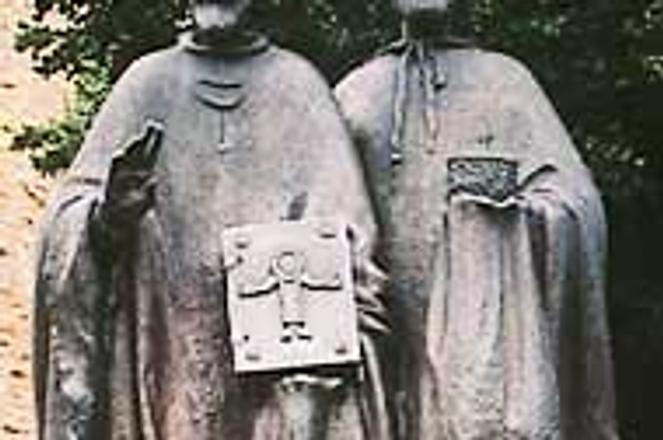BROTHERS and teachers Cyril and Method grace Nitra's centre.photo: Chris Togneri
BEFORE THE ninth century, Catholic Church ceremonies were provided only in three languages: Greek, Latin and Hebrew. The situation changed, however, when two missionaries from Thessalonica entered Slavic territory and codified the local cultural language based upon an Agean-Macedonian dialect, uniting the various central Slavic dialects under the language of Old Church Slavonic.
"The brothers Cyril and Method were ahead of their time. With their activities, they managed to convince the pope to raise the Slavic language to an official church language," says historian Anton Števko, director of the Ponitrianske Museum in Nitra.
Byzantine Emperor Michael III sent the two missionaries to Slavic territory at the request of Rastislav, Prince of the Great Moravian Empire. Rastislav wanted to create an independent church hierarchy within the empire that would resist the pressure of Bavarian missionaries.
For planting the seeds of Slovak history in the town of Nitra, larger-than-life statues of Cyril and Method stand at the foot of Nitra castle and remind passers-by of the origins of the Slovak language.
The town of Nitra, which now governs one of the country's eight regions - the southern Nitra region, used to be the centre of the entire Great Moravian Empire, which reached its political and territorial apex during the 9th century, covering an area larger than the modern-day Czech and Slovak Republics.
"Nitra used to be the centre of power and culture here. It was the first place in our territory to be settled by the Slavic tribes," says Števko.
In the late 5th century, Slavic tribes, coming from the territory bordered by Dnieper and Vistula rivers, began to settle in the basins of the Labe (Elbe) and Morava rivers in the modern-day Czech Republic, and Váh and Dunaj (Danube) in Slovakia. The most significant settlement was built atop the Zobor hill in the Nitra region. Even today, archaeologists, and often people simply visiting, still uncover new findings from the earliest periods there.
"We say here that anybody who comes to Zobor with a hack and smacks the ground with it always finds something," says a guide at the Ponitrianske Museum. "The most ridiculous thing is that those who have better luck there are ordinary people who take the objects home with them. This obviously makes the archaeologists furious."
In 623, a Frankish salesman named Samo managed to join some of the Slavic tribes under his leadership. Despite his empire's short duration, only 30 years, it was the first step to a politically organised Slavic society, says Števko.
From then on, Slavic tribes had to fight for power with Avar tribes. In the 9th century, when Avar supremacy was overthrown completely, two counties were formed: Morava county in present-day Czech territory, led by Mojmír; and Nitra county, in modern Slovak territory, by Pribina. In 833, Prince Mojmír the 1st kicked Pribina out of Nitra and united the counties into the Great Moravian Empire.
Under Prince Pribina - the first Slavic ruler on Slovak territory in its history - the roots of Roman Catholicism were also planted with the consecration of the first Christian church in what was then called Nitrava county in 828.
NITRA'S Andrej Bagar theatre is one of the country's most important cultural institutions.photo: Ján Svrček
"It's assumed that Pribina married a princess, who most probably was a Christian. It was probably the reason why he ordered the building of the church, because he himself was a pagan," says Števko.
Historians are not sure where exactly the Pribina church used to stand, but based on excavations of foundation structures, they assume it was under the Zobor hill. Locals, though, call the St. Emeram Basilica, one of three churches that form the Nitra castle, after Pribina.
Although the current castle complex has been standing there only since the 11th century - individual parts come from several different periods - the local myth might bear a bit of truth. The most recent research on the castle has revealed remains that originated in the 9th century.
"Nitra is the origin of the oldest see not only in Slovakia but in central Europe. Since the 12th century until now, the castle has been the seat of the Nitra Bishop," the historian says.
Cyril and Method, however, were not the first missionaries who brought Christianity to this territory. What matters is that they enabled the locals to read the Bible and listen to mass in the language they spoke.


